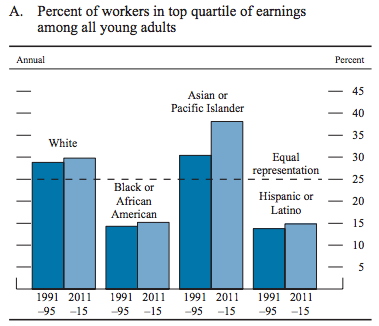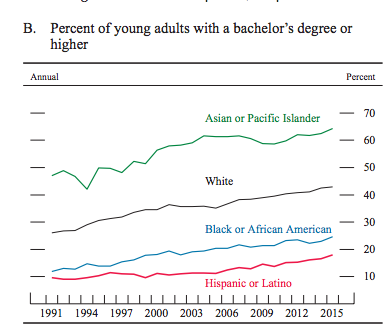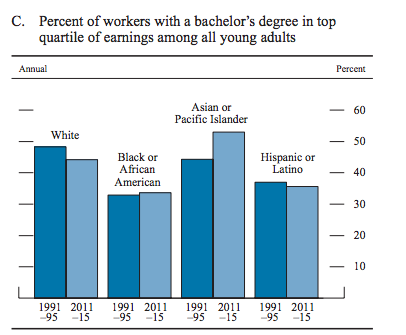There’s a growing tendency for mainstream economists, including several of those at the Federal Reserve, to dismiss all income disparities as the product of a skills- or education gap, a misleading explanation given weak wage growth that points to ongoing weakness in the job market.
So it was relieving to see, tucked in the US central bank’s latest semi-annual report to Congress on monetary policy, an analysis of recent inequality research that refutes the idea that education is the only factor behind income inequality. Race, unsurprisingly, also plays a major role, as do social and economic measures, including taxation, interest rates, and labor policies. The Fed states:
“The persistent gaps in economic outcomes by race and ethnicity in the United States raise important questions about how people ascend the economic ladder. Education, particularly a college degree, is often seen as a path to improved economic opportunities.
“However, while education continues to be an important determinant of whether one can climb the economic ladder, sizable differences in economic outcomes across race and ethnicity remain even after controlling for educational attainment. Data on earnings for two cohorts of young adult workers (aged 25 to 34) approximately a generation apart confirm both the gaps in economic outcomes and the lack of substantial upward progress for disadvantaged groups over the past quarter-century.”
The chart below shows the proportion of young US workers in each ethnicity whose income ranks among the top 25% of the population. Whites are more than twice as likely as blacks to make it into that category, with about 30% of young white adults in the top quartile, compared to just approximately 15% of young black adults.

“Overall, the representation of black and Hispanic workers in the top earnings quartile continues to lag in the later period,” the report adds.
"This lag in representation occurs despite the gains in educational attainment - the critical driver of improved incomes - that blacks and Hispanics have achieved over time. For both blacks and Hispanics, the share achieving a bachelor's degree or higher has doubled over the period of study," as can be seen in the following chart:

Moreover, as the Fed report notes, "increased levels of educational attainment across all groups have created greater competition for positions at the top of the economic ladder. Even among those with college degrees, important differences remain in representation at the top of the income distribution by race and ethnicity."
That's shown in this chart revealing the apparent returns on a college education is substantially higher for whites and Asians than blacks and Hispanics. Some 45% of whites with a college degree make it into the top quartile of earnings among young adults, compared with just 35% for black Americans and just slightly higher for Hispanics.


